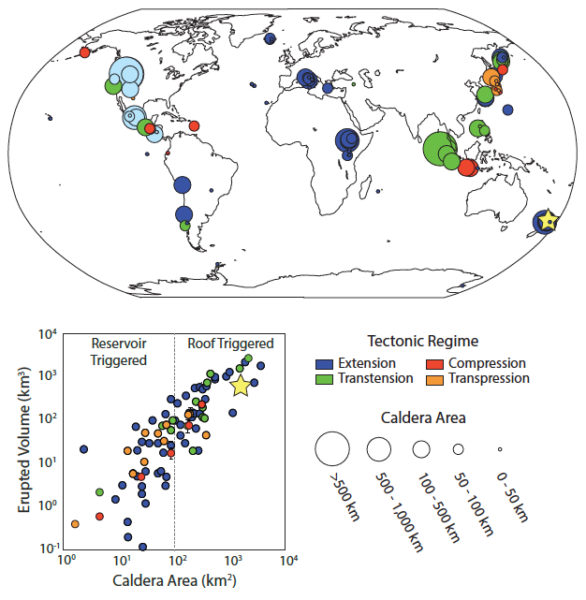Quite often when I work with students I learn at least as much as they do. That was definitely the case when collaborating with Haley Cabaniss and her advisor Dr. Patricia Gregg (UIUC) on the project “The Role of Tectonic Stress in Triggering Large Silicic Caldera Eruptions,” recently published in Geophysical Research Letters.

As you can observe in the figure above, most large calderas (area > 100 km^2) form in regions characterized by tectonic extension or transtension, whereas calderas forming in regions of compression or transgression tend to be smaller in size. Using temperature-dependent viscoelastic numerical models we assessed the 3D mechanical stability of large magma reservoirs as new molten material is added to them over time, and demonstrated three key things: (1) magma reservoirs fail (forming calderas) most readily and/or at the lowest magma flux rates when located in tectonic regimes characterized by extension; (2) compressive tectonic regimes can stabilize reservoirs initially, but eventually assist destabilization (relative to models without any regional tectonic stresses) due to strain accumulation; and, (3) even very large magma reservoirs will remain mechanically stable for only 100’s-1000’s of years during a magmatic fluxing event, a time frame which is geologically quite rapid yet likely to provide ample warning of a pending eruption on human time scales. This suite of results advances our insight into large magma reservoirs significantly, and to first order matches observations at persistently active systems like Taupo in New Zealand, thus aiding efforts to better understand one of the most hazardous of geological phenomena–a caldera-forming ‘supereruption.’
Reflecting this excitement, it was fun to see the resulted shared in venues like Newsweek and Forbes!
For more information see: UIUC Press Release and original article in GRL.